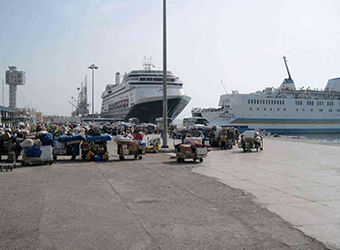Egypt is set to build the largest seawater desalination plant in the world in the Red Sea city of Ain Sokha, head of the Egyptian Armed Forces Engineering Authority, Kamal El Wazir, said earlier this week.
Upon completion, the plant will be able to purify 164,000 cubic metres of seawater per day, and will provide water to development projects in the Suez Canal Economic Zone, Wazir said in a phone interview on private TV channel ONTV.
Currently in the process of being built, the plant will “benefit the economic zone located northwest of Suez Gulf, as well as supporting three other giant desalination plants located in al-Galala, east of Port Said Governorate and the New El Alamein city,” he explained.
Meanwhile, the Ministry of Housing’s facilities advisor Sayed Ismail told ONTV that these other three desalination plants are currently under construction, each with a production capacity of 150,000 cubic meters per day.
Ismail went on to say that the country’s overall water desalination capacity at present stands at 700,000 cubic meters per day, representing a tenfold increase in the past two years.
Multiple scientific studies have highlighted that Egypt in recent years has increasingly been suffering from a serious problem with water shortage.
The river Nile’s fresh water is continuously decreasing due to human activity. Uneven distribution of water, inefficient agricultural irrigation techniques and misuse of scarce water resources are some of the reasons the country’s water security is under threat.
“With a population expected to double in the next 50 years, Egypt is projected to reach a state of serious country-wide fresh water and energy shortage by 2025,” said a recent report by the Geological Society of America.
Egypt’s volume of renewable freshwater is just 20 cubic meters per person, a significantly low figure compared to international standards. CAPMAS, the country’s official statistics agency, said in 2014 that since 1947, Egypt’s annual water quota per person has declined by 60 percent. By 2025, the situation is projected to become even worse, with the country facing a situation of “absolute water scarcity”.
Egypt’s water security is further threatened by the Grand Ethiopian Renaissance Dam project currently being built and which Egyptian authorities warn may reduce Egypt’s water supply even further. About 70 percent of the water flowing into Egypt derives from the Blue Nile and Atbara river, both of which are located in Ethiopia.
The past two centuries have seen human activity seriously alter the flow conditions of the river Nile in Egypt. The introduction of barrages in the 1800s and the construction of the Aswan Low and High Dams a century later have changed the distribution of water and organic-rich soil in the Nile delta. In addition, the building of ‘New Towns’ in Egypt’s water-scarce vast desert lands since the early 1980s has contributed to decreasing the country’s un-renewable groundwater sources.
As the Nile historically has been Egypt’s main source of freshwater, the new seawater desalination plants are part of ongoing efforts to diversify the country’s freshwater sources and secure its water supply.
Source: Egyptian streets
